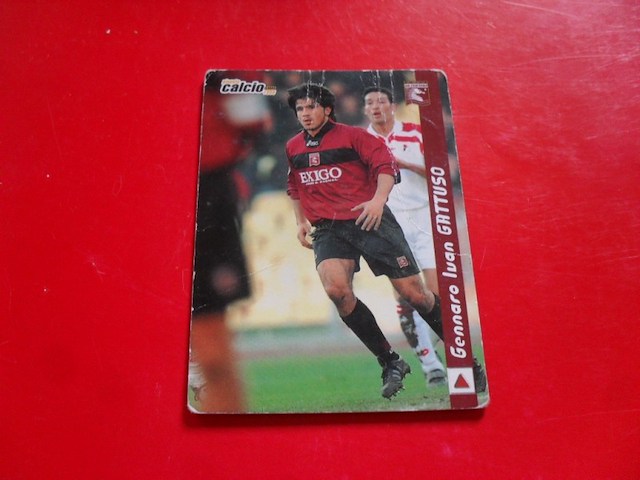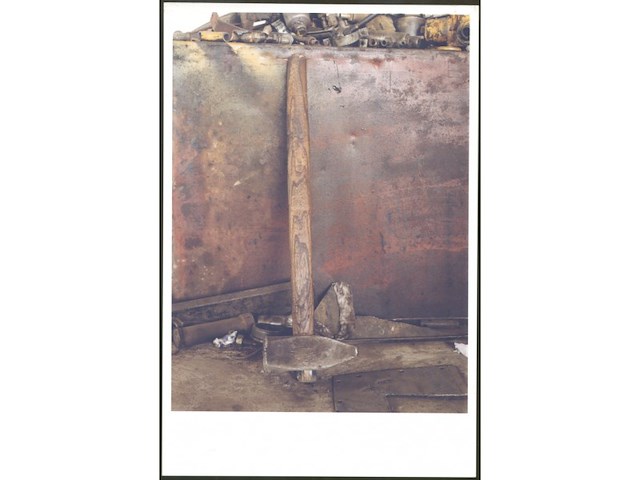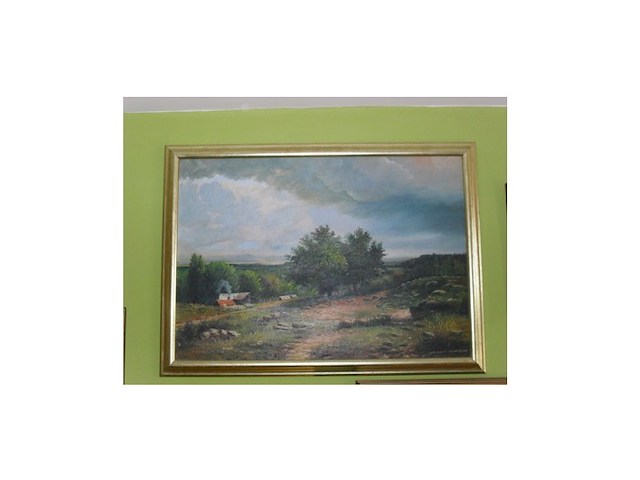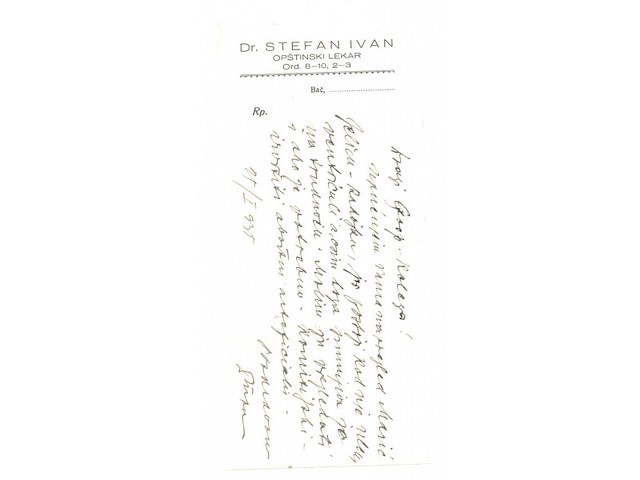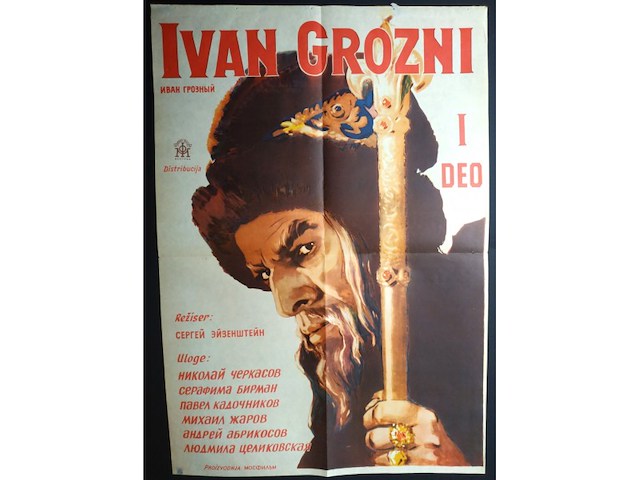Pratite promene cene putem maila
- Da bi dobijali obaveštenja o promeni cene potrebno je da kliknete Prati oglas dugme koje se nalazi na dnu svakog oglasa i unesete Vašu mail adresu.
76-100 od 583 rezultata
Prati pretragu "ivan"
Vi se opustite, Gogi će Vas obavestiti kad pronađe nove oglase za tražene ključne reči.
Gogi će vas obavestiti kada pronađe nove oglase.
Režim promene aktivan!
Upravo ste u režimu promene sačuvane pretrage za frazu .
Možete da promenite frazu ili filtere i sačuvate trenutno stanje
Aktivni filteri
-
Tag
Kolekcionarstvo i Umetnost
-
Kolekcionarstvo i umetnost chevron_right Kolekcionarstvo
Razglednica u odličnom stanju. Stanje kao na slikama. Pogledajte i ostalu ponudu razglednica na Kupindu možda pronađete još koju zanimljivu. https://www.kupindo.com/pretraga.php?Pretraga=&CeleReci=0&Prodavac=topsy5&Grupa=1126
-
Kolekcionarstvo i umetnost chevron_right Kolekcionarstvo
Vidi sliku. Poster šaljem preporučenom tiskovinom. Uplata post netom ili na tekući račun banke Poštanska štedionica 200-58999105-62 Po završetku aukcije, najbolje bi bilo da se čujemo telefonom ili preko limundo poruka, radi dogovora oko uplate i slanja postera. POSTER SE PRODAJE U STANJU PRIKAZANOM NA SLICI, ako niste sigurni u zadovoljavajući kvalitet, NE LICITIRAJTE
30 x 20 cm potpisana signed b/w photography, fiber-based paper Born in Kruševac in 1973, Serbia, (lives in Belgrade) Graduated in 2002 on the Academy of Arts “Braća Karić”, photography department, Belgrade, Serbia. Founder and editor of the Cenetr for photography, (along with Mihailo Vasiljević), an independent non-profit organization established in Belgrade in 2011 for research, study and promotion of photography. Initiator and editor of Foto Forum, a series of interviews with photographers and artists on which present and promote local contemporary photographic production (Students’ City Cultural Center, 2010-2011) From 2013 lecturer of photography school in Center of Fine Arts & Education Šumatovačka in Belgrade, Serbia He received Dimitrije Bašičević Mangelos award (2008) for the best young visual artist in Serbia Selection from the one-man exhibition 2012 Reconstruction, Street Gallery, Belgrade, Serbia ФОТО, Gallery of Students’ city cultural center, Belgrade, Serbia The Documents, Cultural centre RIBNICA, Kraljevo, Serbia The Documents, Gallery of Centre for Culture in Sopot, Sopot, Serbia Underground shelters, Remont gallery (Interrogation, photographers of new generation in Serbia from 2000), Belgrade, Serbia Photo wall-paper, University Library “Svetozar Marković” in Belgrade, (Disruption, with Stefana Savić), Belgrade, Serbia 2009 The Documents, Salon of the Museum of Contemporary Art, Belgrade, Serbia Night spaces, Gallery Remont, Belgrade; Art gallery Kruševac, Serbia 2007 TV or TV, Gallery of Students’ city cultural center, Belgrade, Serbia 2004 Underground shelters, PIROSCHKA rev, MQ-21, Wien, Austria TV or TV, Gallery of the Youth Centre, Belgrade, Serbia 2003 Images, Gallery Remont, (PUNKT, with Mirijana Stojadinović and Andrija Pavlović), Belgrade, Serbia 2002 Registry, April gatherings, Gallery of the Students Culture Centre, Belgrade, Serbia 2001 Vitak 1999, Gallery of the Students Culture Centre, (with Petar Mirosavljević and Vukašin Nedeljković), Belgrade, Serbia Selection from the group exhibitions: 2013 4th Thessaloniki Biennale of Contemporary: Old Intersections – Make it New (central exhibition: Everywhere but Now), Periptero 6, Thessaloniki, Greece Amuse Me, City Gallery of Ljubljana, Slovenia Voies Off Vestival, Le voyage impossible, Arles, France 2012 Aftermath. Changing cultural landscape, Tendencies of engaged post-Yugoslavian contemporary photography, ParCo 2, Pordenone, Italy; National Museum of Slovenia, Ljubljana, Slovenia; 2013 – Klovićevi dvori, Zagreb, Croatia Photodocuments 02, Salon of Museum of Contemporary Art, Belgrade, Serbia What happened to Museum of Contemporary Art?, Museum of Contemporary Art Belgrade, Serbia 2011 DONUMENTA 2011 / Views: Visions – sketches of Serbian art after 2000, Kunstforum Ostdeutsche Galerie, Regensburg, Germany No Network-Time machine, D-O ARK Underground, site specific intervention, permanent installation, Konjic, BiH 2010 Photo documents, Site specific intervention, Museum of Railway Požega, permanent installation, Požega, Serbia Photonic Moments, The Month of Photography, The New Serbian Photography, Gallery Simulaker, Novo Mesto, Slovenia 25th Nadežda Petrović Memorial “I am what I am”, Art Gallery Nadežda Petrović/Čačanska Gimnazija, Čačak, Serbia 2009 Remont u Puli, Stara Tiskara in Pula, Pula, Croatia Snooze, Scaramuche@Fruit & Flower Deli gallery, New York, USA Land of Promises, Gallery ArtPoint, Wien, Austria; 2008, Cultural centre of Serbia, Paris, France; 2007, Gallery Apollonia, Strasbourg, France 2008 Photonic Moments; Cankarjev dom, Ljubljana, Slovenia It’s raining outside, but I don’t believe that it is; Banja Luka, Repabik of Srpska Still in time, Kunstraum BLAST, Cologne, Germany For a happier tomorrow; Gallery Tom Christoffersen, Copenhagen, Denmark Micro narratives; Musée d’art moderne, Saint Etienne, France 2007 Micro narratives; 48. October salon, Belgrade, Serbia 2006 Recognition; Art Gallery Nadežda Petrović, Čačak, Serbia; 2005 Actual Serbian photography; FOTOHOF Gallery, Salzburg, Austria 2004 VI biennale of the young artists; Vršac, Serbia Strange point of tension; Biljarda, Cetinje, Monte Negro Nus phenomenon; Gallery Nova, Zagreb, Croatia 2002 The annual exhibition of the centre for contemporary arts; Salon of the Museum of Contemporary Art, Belgrade, Serbia 2001 The Month of Photography; The Gallery of the Academy of Arts, Belgrade, Serbia Published Works: Critical Dictionary, 2011; 154-157; edited by David Evans; Black Dog Publication, London, UK; ISBN 978 1 907317 49 1 Artist and Residence program: 2004 KulturKontakt scholarship, Vienna, Austria 2011 Künstlerhaus, Schwandorf, Germany Artist talk performances: 2013 Seven Diferent Initiatives to Overcome…(along with UnaPopović), Künstlerhaus Bremen, Germany 2012 Artist as Audience, Museum of Contemporary Art, Belgrade, Serbia 2011 Documentarism – Appropriation – Revaluation, Galerie Für Zeit Genössische Kunst, Laipzig, Germany Curatorial projects: 2012 In a full light – photographs from the collection of the Center for Photography (along with Mihailo Vasiljević) - as part of the exhibition Photodocuments 02, Remont Gallery, Belgrade
-
Kolekcionarstvo i umetnost chevron_right Kolekcionarstvo
Razglednice skeniram tako da imate uvid u njihovo stanje
-
Kolekcionarstvo i umetnost chevron_right Kolekcionarstvo
Razglednice skeniram tako da imate uvid u njihovo stanje
-
Kolekcionarstvo i umetnost chevron_right Kolekcionarstvo
razglednice skeniram tako da imate uvid u njihovo stanje
-
Kolekcionarstvo i umetnost chevron_right Kolekcionarstvo
Razglednice skeniram tako da imate uvid u njihovo stanje
-
Kolekcionarstvo i umetnost chevron_right Kolekcionarstvo
nije putovala
-
Kolekcionarstvo i umetnost chevron_right Kolekcionarstvo
(RUS1)797. Rusija 1982 slikar Ivan Ivanovič Šiškin, čisto (**) Michel 5144
PRVI DAN F D C IVAN ZAJC 1832-1914 JUGOSLAVIJA 1 9 8 2 PTT - 10/82 KOVERAT SA STILIZOVANIM LIKOM IVANA ZAJCA + ŽIGOSANA POŠTANSKA MARKA SA SLIKOM IVANA ZAJCA + ŽIG POŠTE 111010 BEOGRAD + DATUM U ŽIGU 3.8.1982 ...................................................... NEKORIŠĆENO EKSTRA ********* dsp19/ljk60
-
Kolekcionarstvo i umetnost chevron_right Kolekcionarstvo
Recept Dr.Stefan Ivan Bač 1935.Kraljevina Jugoslavija Godina: 1935. Srednje Očuvano. Stanje Kao Na Fotografijama
-
Kolekcionarstvo i umetnost chevron_right Kolekcionarstvo
48 x 68 cm 2 x presavijen, IVICE SECENE i RUPICE movie poster, AFFICHE de FILM Ivan Grozni (sh. Иван Грозный) je sovjetski crno-beli istorijski film u dva dela, sniman od 1942. do 1946. godine u režiji Sergeja Ejzenštejna, poznat kao posljednji u njegovoj filmografiji. U njemu je prikazan život i vladavina ruskog cara Ivana IV Groznog, čiji lik tumači Nikolaj Čerkasov. Film je nastao za vreme drugog svetskog rata, odnosno u vreme kada se Ejzenštejn, kao i mnogi drugi sovjetski filmaši, zbog nemačke invazije sklonio u Alma Atu u današnjem Kazahstanu. Temu za film je predložio sovjetski vođa Staljin koji je Ivana Groznog smatrao jednim od svojih istorijskih uzora, odnosno priču o njegovoj vladavini prikazati kao alegoriju na vlastiti režim. Film se originalno trebao snimiti u tri dela. Prvi deo, koji prikazuje rane godine Ivanove vladavine, njegove ratne uspehe i podršku među ruskim seljacima, je prikazan krajem 1944. godine i dobio je Staljinovu nagradu. Drugi deo, u kome se prikazuju Ivanovi obračuni za boljarima, ali i njegova sve veća okrutnost i paranoja, su, pak, od režimskih cenzora prepoznati kao implicitna kritika Staljinovih metoda vladavine. Zbog toga je drugi dio filma završio u bunkeru, te je prikazan tek nakon Staljinove smrti 1958. godine. Treći deo je, sprečila Ejzenštejnova smrt. Usprkos toga, Ivan Grozni se smatra jednim od najvažnijih i najzanimljivijih Ejzenštejnovih filmova. Drugi deo takođe sadrži nekoliko sekvenci snimljenih u boji, što je bio prvi takav slučaj u istoriji sovjetske kinematografije. Godine 1962. je ušao u izbor 10 najboljih filmova svih vremena u prestižnoj anketi britanskog filmskog časopisa Sight & Sound. --------------------------------------------- Sergej Mihailovič Ejzenštajn (23. januar 1898. — 11. februar 1948) je sovjetski reditelj i filmski teoretičar. Najpoznatiji filmovi su mu: „Oklopljača Potemkin“, „Oktobar“, „Aleksandar Nevski“. Njegovi filmovi pripadaju žanru politički angažovanih filmova. Među istoričarima filma postoji uverenje da je upravo Sergej Ejzenštajn doprineo najviše razvoju montaže, kao ne samo tehničkog postupka povezivanja kadrova, nego kao i načina da se filmski jezik bitno izmeni i unapredi. Sa Lavom Kulješevim razvio je izuzetno značajan teoretski rad na polju razvoja montaže. Svo delo Sergeja Ejzenštajna karakteriše inovativna upotreba montaže, ritma, odabira dominantnih motiva, vrste osvetljenja, u poslednjem filmu i upotreba boja. Ove je bila inovacija u filmskom rečniku svoga doba. Potiče iz porodice u kojoj je dominantno religijsko uverenje bilo pravoslavlje, iako mu je otac, po nacionalnosti bio Jevrejin koji je prihvatio pravoslavlje, a majka Ruskinja. U svojim prvim filmovima nije koristio glumce profesionalce. Bavio se pitanjima klasnih konflikta u kojima su glumci imali stereotipne uloge. Ejzenštajn je bio odan idejama komunizma u vreme Staljina koji je odlično shvatao značaj filma kao propagandnog oružja. Popularnost i značaj Sergeja Ejzenštajna je rastao i opadao u funkciji uspeha njegovih filmova. Godine 1925, stvorio je film „Oklopnjača Potemkin“. Čuvenu scenu sa kolicima koja padaju niz stepenište u Odesi snimio je 22. septembra. Centralni komitet KPSS je organizovao obeležavanje jubileja revolucije iz 1905, a narodni komesari Lunačarski i Maljevič su angažovali Ejzenštajna da napravi film posvećen ovoj komemoraciji. Od mnoštva događaja, Sergej je odabrao pobunu na oklopnjači kao centralni motiv filma. U jesen 1928. godine napušta Sovjetski Savez i odlazi na dvogodišnje studijsko putovanje po Evropi sa saradnicima Edvardom Tiseom i Grigorijem Aleksandrovim. Tamo ih je poslala komunistička partija da bi usavršili saznanja o tehnici zvučnog filma. Tu je napravio jedan film u Francuskoj (Sentimentalna romanasa iz 1930). Studio Paramaunt ga 1930. poziva u SAD i nudi ugovor na 100.000 dolara. Ejzenštajn stiže u Njujork 20. maja. Trebalo je da ekraznizuje jedan od romana Teodora Drajzera, ali se od tog projekta odustalo zbog sukoba reditelja i producenata. Time dolazi u poziciju da ga prijatelji Epton Sinkler i Čarli Čaplin spašavaju od neke vrste progona. Odlazi u Meksiko da snima film za bračni par Sinkler, ali se i tu njegova umetnička priroda susreće sa, za njega u to vreme neprihvatljivim uslovima stvaranja. Film o Meksiku nije dovršen, a Staljin ga u međuvremenu poziva nazad u SSSR. Od snimljenog materijala je 1933. izmontirana verzija filma „Gromovi nad Meksikom“, kasnije poznatog kao „Živeo Meksiko!“ (¡Que Viva México!). Godine 1938. prikazan je prvi Ejzenštajnov zvučni film, „Aleksandar Nevski“. On opisuje istorijsku bitku Rusa i tevtonskih vitezova iz 13. veka na zaleđenom Čudskom jezeru. Filmom dominira ideja patriotizma i stoga je intenzivno korišćen kao propaganda u SSSR-u tokom Drugog svetskog rata. Ejzenštajnov boravak na zapadu ga je učinio sumnjivim u očima Staljina i komunističke nomenklature. Rad na nekim filmovima je otkazan, a rad na filmu „Ivan Grozni“ je često ometan. Prvi deo ovog filma iz 1944. primljen je sa simpatijama i nagrađen je, dok je drugi deo bio cenzurisan i nije prikazan do 1958. U nastavku filma, Ivan nije prikazan kao heroj već kao paranoični tiranin. Neki delovi su snimljeni u koloru, zahvaljujući nemačkim kolor kamerama zaplenjenim u bici kod Staljingrada. Treći deo filma, iz 1946, konfiskovala je komunistička partija. Sergej Ejzenštajn je umro od srčanog udara, 11. februara 1948. u Moskvi. ----------------------------------------------------------- Sergei Mikhailovich Eisenstein (22 January [O.S. 10 January] 1898 – 11 February 1948) was a Soviet film director and film theorist, a pioneer in the theory and practice of montage. He is noted in particular for his silent films Strike (1925), Battleship Potemkin (1925) and October (1928), as well as the historical epics Alexander Nevsky (1938) and Ivan the Terrible (1944, 1958). In its 2012 decennial poll, the magazine Sight & Sound named his Battleship Potemkin the 11th greatest movie of all time. ----------------------------- Ivan the Terrible (Russian: Иван Грозный, Ivan Grozniy) is a two-part historical epic film about Ivan IV of Russia, written and directed by the filmmaker Sergei Eisenstein. It was commissioned by Soviet Premier Joseph Stalin, who admired and identified himself with Ivan. Part I was released in 1944; Part II was not released until 1958, as it was banned on the order of Stalin, who became incensed over the depiction of Ivan therein. Eisenstein had developed the scenario to require a third part to finish the story but, with the banning of Part II, filming of Part III was stopped; after Eisenstein`s death in 1948, what had been completed of Part III was destroyed. PART 1 In the prologue Ivan`s mother and her lover are murdered by the boyars. Later Ivan is enthroned as Grand Prince of Moscow. Part I begins with Ivan`s coronation as Tsar of all the Russians, amid grumbling from the boyars. Ivan makes a speech proclaiming his intent to unite and protect Russia against the foreign armies outside her borders and the enemies within – a reference to the boyars, who are already seen as discontented with his coronation. Shortly after, Ivan marries Anastasia Romanovna and there is a wedding celebration. This causes him to lose the friendship of his two best friends, Prince Andrei Kurbsky and Fyodor Kolychev. The latter receives Ivan`s permission to retire to a monastery, while Kurbsky attempts to resume his romance with the Tsarina, who repels his advances. The marriage feast is interrupted by news of the burning of several boyar palaces, carried into the Tsar`s palace by a mob of the common people who also complain that the Tsar is being led astray by the Tsarina`s family (the Romanovs), the Glinskys and the Zakharins. Ivan calms the crowd, but is interrupted by envoys from the khanate of Kazan, who send him a ceremonial knife with the suggestion that he do himself a favor by using it to commit suicide. Ivan immediately proclaims that his kingdom is at war with Kazan. The next scene shows the siege of Kazan, in which Ivan`s army digs saps underneath the city and fills them with gunpowder. Kurbsky, nominally in command, is reprimanded by Ivan for senseless brutality (he ties Tartar prisoners to palisades within earshot of the walls of Kazan and tells them to shout to the city to surrender; the defending archers immediately shoot the prisoners). The city of Kazan falls to the Russian army. During his return from Kazan, Ivan falls seriously ill and is thought to be on his deathbed; Orthodox priests come to give him the last rites before he dies. Ivan sends for his relatives and orders them to swear allegiance to his son, the infant Dmitri, reminding them of the need for a single ruler to keep Russia united. They demur, with Ivan`s aunt, Efrosinia Staritskaya, openly urging the others to swear allegiance to her son, Vladimir, instead. Emotionally overwrought, Ivan collapses and is thought dead. The relatives, celebrating, all begin to swear allegiance to Vladimir, the `boyar tsar` they have hoped for; meanwhile, Kurbsky is uncertain of his own loyalty, trying to decide between the two sides. However, when the Tsarina says, `Do not bury a man before he is dead,` Kurbsky realizes that Ivan is still alive, and hurriedly swears his allegiance to Ivan`s infant son, Dmitri. He is sent, as a reward, to the western border of the kingdom to defend against the Livonians and Poles. At the same time, Ivan dispatches Alexei Basmanov, a commoner he likes, to the south to take care of the Crimean border. The fact that Ivan promotes a commoner over them creates more discontent amongst the boyars. The Tsarina now falls ill, and while Ivan is receiving bad news from all fronts, the boyars plot to kill her. Efrosinia comes into the palace with a cup of wine hidden in her robes, in which she has put poison. Just as the royal couple receive word that Kurbsky has defected to the Livonians, Efrosinia slips the cup of wine into the room and listens from behind a wall. The news that Kurbsky is a traitor gives the Tsarina a convulsion and Ivan, looking around for a drink to calm her, takes the poisoned wine and gives it to her. The scene changes to show the dead Tsarina lying in state in the cathedral, with Ivan mourning beside her bier. While a monk reads biblical verses over the body, Ivan questions his own justifications and ability to rule, wondering if his wife`s death is God`s punishment on him. However, he pulls himself out of it, and sends for Kolychev. At this point, Alexei Basmanov arrives, suggesting that Ivan surround himself with men he can trust – common people, `iron men,` the Oprichniki – and offers his (rather startled) son, Fyodor, for service. Ivan accepts, and sets about recouping his losses. He abdicates and leaves Moscow, waiting until the people beg him to return, saying that he now rules with absolute power by the will of the people. PART 2 Part II opens in the court of King Sigismund of Poland, to whom Kurbsky swears allegiance. Sigismund promises to make Kurbsky ruler of Ivan`s territories, once he exploits the tsar`s absence by conquering them. The plan is foiled when an emissary announces that Ivan has returned to Moscow. Ivan begins by reforming the land distribution: he takes the boyars` lands, then reinstalls them as managers, increasing his own power at their expense. His friend, Kolychev, arrives, now the monk Philip; after a heated debate, Philip agrees to become metropolitan of Moscow, if Ivan gives him the right to intercede for condemned men. This is mutually agreed upon. But as soon as it is settled, Ivan, propelled by his lieutenant Malyuta Skuratov, finds a way around this: he executes condemned men quickly, before Philip can use his right. In this way he has three of Philip`s kinsmen executed. Fyodor Basmanov, the first of the Oprichniki, helps Ivan figure out that the Tsarina was poisoned, and both suspect Efrosinia of poisoning the cup of wine. Ivan orders Fyodor not to say anything about it until he (Ivan) is certain beyond doubt of her guilt. The boyars, close to desperation, plead their case to Philip and eventually win him over. He vows to block Ivan`s abuse of power, and confronts him in the cathedral while a miracle play is being presented. As the argument heats up, Ivan, angry, proclaims that he will be exactly what the boyars call him – terrible – and has Philip seized. The boyars now decide that their only option is to assassinate Ivan, and the novice Pyotr is selected to wield the knife. Ivan, now certain of Efrosinia`s guilt, invites Vladimir, her son, to a banquet with the Oprichniki. (From here, the film is in colour.) Ivan gets Vladimir drunk while the Oprichniki sing and dance around them; Vladimir mentions that there is a plot to kill Ivan, and he, Vladimir, is to replace him as Tsar. Fyodor Basmanov notices the assassin leaving, and signals to Ivan, who, pretending surprise at Vladimir`s revelation, suggests Vladimir try being Tsar for a while, and has the Oprichniki bring throne, orb, scepter, crown and royal robes, and they all bow down to `Tsar Vladimir.` Then Ivan tells Vladimir to lead them to the cathedral in prayer, as a Tsar should lead. (Back to black-and-white.) Hesitantly, Vladimir does. In the cathedral, the assassin runs up, stabs the mock Tsar and is immediately seized by Fyodor and Malyuta. Efrosinia arrives, jubilant at the apparent death of Ivan, until she sees Ivan alive; rolling the corpse over, she realizes it is her own son. Ivan orders Fyodor and Malyuta to release Pyotr, the assassin, and thanks him for killing not only “a fool”, but “the tsar`s worst enemy”. He sentences Efrosinia, who is holding the crown her son was wearing and is singing over his dead body as if deranged. (Back to colour.) At the end, Ivan is seen proclaiming that all his enemies within Moscow are ruthlessly vanquished and he can now turn his attention to those outside.


